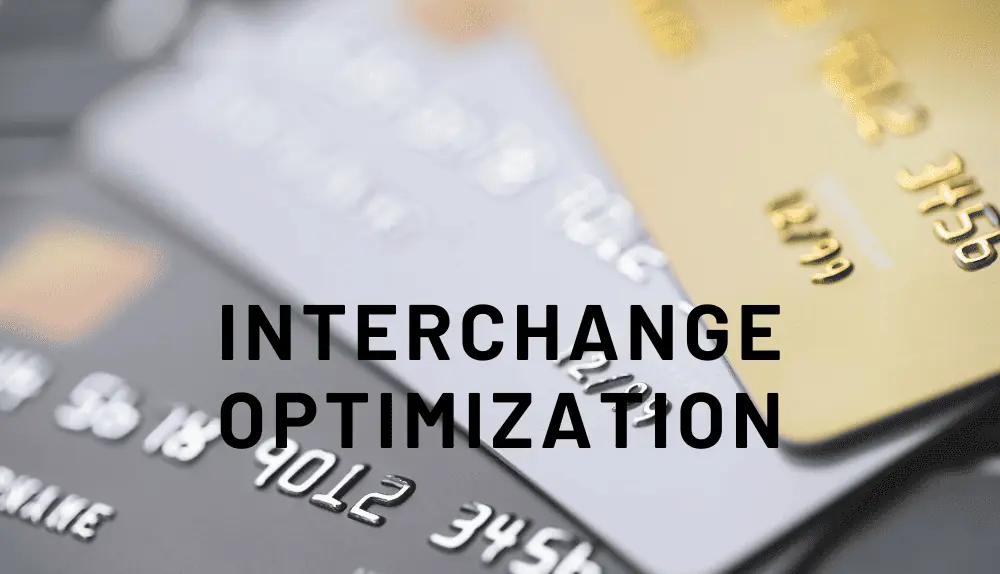In a world driven by electronic payments, businesses face the inevitable reality of credit card processing fees. But what if there was a way to unlock substantial savings within this payment ecosystem? Enter interchange optimization, a powerful strategy that can help businesses of all types and sizes minimize those fees and reclaim a significant portion of their hard-earned revenue. While interchange optimization offers benefits across industries, it proves particularly advantageous for business-to-business companies, who often encounter transaction downgrades.
In this article, we’ll delve into the transformative potential of interchange optimization, unveiling how it can revolutionize your business’s financial landscape and pave the way for substantial cost savings. Get ready to embark on a journey where every payment becomes an opportunity for maximizing your profits and optimizing your financial success.
What is Interchange Optimization?
Interchange optimization is a strategic approach aimed at minimizing credit card processing fees and maximizing cost savings for businesses. When a customer makes a payment using a credit card, a portion of that transaction amount is paid to the card-issuing bank, which is known as the interchange fee. These fees can vary based on various factors, such as the type of card used, the industry of the business, and the way the transaction is processed.

Interchange optimization involves analyzing and optimizing the payment processing system to reduce these interchange fees. It requires a thorough understanding of the different interchange rates and fee structures associated with various types of transactions. By identifying and implementing strategies to minimize transaction downgrades, such as using more efficient payment processing methods or capturing additional transaction data, businesses can potentially qualify for lower interchange rates.
The ultimate goal of interchange optimization is to streamline the payment process, reduce unnecessary expenses, and improve the bottom line for businesses. By effectively managing interchange fees, businesses can save significant amounts of money, which can be reinvested into growth initiatives or contribute to increased profitability.
Who Benefits from Interchange Optimization?
Interchange optimization benefits a wide range of businesses and stakeholders involved in the payment processing ecosystem. Let’s explore the different groups that can reap the advantages of interchange optimization:
Businesses of all sizes
Interchange optimization offers substantial cost savings to businesses across industries and of various scales. Whether it’s a small local retailer or a large multinational corporation, businesses can benefit from reduced interchange fees, leading to increased profitability and improved cash flow.
Business-to-Business (B2B) companies
B2B companies often engage in high-value transactions, making them particularly susceptible to transaction downgrades. Interchange optimization provides significant value to B2B businesses by minimizing downgrade-related fees and optimizing their payment processes, resulting in substantial savings.
E-commerce and Online Businesses
In the digital era, e-commerce and online businesses rely heavily on electronic payments. Interchange optimization allows these businesses to reduce processing costs, optimize payment gateways, and improve the overall efficiency of their online transactions.
Payment Service Providers (PSPs)
PSPs play a crucial role in facilitating payment transactions for businesses. By implementing interchange optimization strategies, PSPs can enhance their services, attract more clients, and provide cost-saving solutions that strengthen their competitive edge.
Consumers
While interchange optimization primarily benefits businesses, it can indirectly benefit consumers as well. When businesses save on interchange fees, they may pass on some of those savings to consumers through reduced prices, promotions, or improved services.
Overall, interchange optimization is a win-win scenario, benefiting businesses, B2B companies, e-commerce ventures, payment service providers, and ultimately, consumers. It unlocks cost-saving opportunities, streamlines payment processes, and creates a more efficient and sustainable payment ecosystem for all parties involved.
Does Interchange Optimization Help to Save Money?
Interchange optimization is specifically designed to help businesses save money. By implementing interchange optimization strategies, businesses can minimize credit card processing fees and maximize cost savings. Here’s how interchange optimization contributes to saving money:
Reduced Interchange Fees
Interchange fees are a significant component of credit card processing costs. Interchange optimization involves analyzing the fee structures associated with different types of transactions and identifying opportunities to qualify for lower interchange rates. By effectively managing interchange fees, businesses can reduce their payment processing expenses and save money.
Transaction Downgrade Mitigation
Transaction downgrades occur when a payment transaction does not meet certain criteria, resulting in higher interchange fees. Through interchange optimization, businesses can implement measures to minimize transaction downgrades, such as capturing additional transaction data or using more efficient payment processing methods. By avoiding downgrades, businesses can prevent unnecessary fees and save money.
Streamlined Payment Processes
Interchange optimization focuses on optimizing payment processes to make them more efficient and cost-effective. By streamlining payment workflows, businesses can minimize manual errors, improve operational efficiency, and reduce associated costs. This streamlined approach saves both time and money in the payment processing cycle.
Increased Profitability
By saving money through interchange optimization, businesses can allocate those funds to other areas of their operations, such as marketing, product development, or expansion initiatives. This increased profitability leads to a healthier bottom line and the potential for further business growth.

Overall, interchange optimization is a strategic approach that helps businesses save money by minimizing interchange fees, mitigating transaction downgrades, streamlining payment processes, and ultimately increasing profitability. It provides businesses with the opportunity to optimize their financial resources and allocate them toward achieving their broader goals.
How to Lower Processing Fees with Interchange Fees
Lowering processing fees through interchange optimization involves implementing strategies to qualify for lower interchange rates. Here are some approaches that can help reduce processing fees
Understand Interchange Categories
Gain a deep understanding of the various interchange categories and rates set by card networks like Visa, Mastercard, and American Express. Each category corresponds to different types of transactions, such as debit cards, credit cards, and rewards cards. By familiarizing yourself with these categories, you can identify the ones that offer lower interchange rates and structure your payment acceptance accordingly.
Capture Additional Transaction Data
Provide more detailed transaction information when processing payments. By capturing additional data points like customer billing address, order information, or product descriptors, you can qualify for lower interchange rates. This data is often used by card networks to assess the risk associated with the transaction and can result in more favorable rates.
Utilize Level 2 and Level 3 Processing
Level 2 and Level 3 processing apply to business-to-business (B2B) transactions and require providing specific data elements such as tax information, customer codes, or invoice details. By utilizing these processing levels, B2B businesses can qualify for reduced interchange rates tailored to their needs.
Optimize Payment Processing Solutions
Choose a payment processor or payment gateway that offers interchange optimization tools and features. Some providers specialize in interchange management and can help you navigate the complex fee structures while ensuring you qualify for the most favorable rates based on your business type and transaction profile.
Regularly Review and Update Processes
Stay up-to-date with industry changes, card network updates, and new interchange rate structures. Regularly review your payment processes and make necessary adjustments to maximize savings. Consider consulting with payment experts or partnering with a payment consultant who can help identify areas for improvement and optimize your interchange rates.
Importance of Level II and Level III Interchange Optimization
Level II and Level III interchange optimization play a crucial role in reducing processing costs and maximizing savings, particularly for business-to-business (B2B) transactions. Here are the key reasons why Level II and Level III interchange optimization are important:
Lower Interchange Rates
Level II and Level III processing offer B2B businesses the opportunity to qualify for lower interchange rates compared to standard consumer transactions. These specialized processing levels require providing additional data elements such as tax information, customer codes, invoice details, and more. By capturing and including this data in the transaction, businesses can access reduced interchange rates specifically designed for B2B transactions. This translates to significant cost savings over time.
Tailored Pricing for B2B Transactions
B2B transactions typically involve higher order values and increased risk compared to consumer transactions. Level II and Level III processing consider these unique characteristics and offer interchange rates that align with the specific needs of B2B businesses. By utilizing these processing levels, businesses can ensure that they are paying interchange fees that are reflective of their transaction types, resulting in fair and optimized pricing.
Enhanced Transaction Data
Level II and Level III processing require businesses to provide detailed transaction data beyond what is typically required in consumer transactions. This additional data includes line-item details, order descriptions, customer information, and more. Access to this enhanced transaction data not only helps businesses qualify for lower interchange rates but also provides valuable insights for financial reporting, inventory management, and customer relationship management. It enables businesses to have a more comprehensive view of their B2B transactions, facilitating better decision-making and operational efficiency.
Competitive Advantage in B2B Market
By implementing Level II and Level III interchange optimization, B2B businesses can gain a competitive edge in their industry. Lower interchange rates lead to reduced processing costs, allowing businesses to offer more competitive pricing to their customers. This can help attract new clients, retain existing ones, and improve overall profitability. Additionally, businesses that can demonstrate their ability to optimize interchange rates and provide detailed transaction data may be perceived as more reliable and trustworthy partners in the B2B market.
Level II and Level III interchange optimization are essential for B2B businesses due to the tailored pricing, lower interchange rates, enhanced transaction data, and competitive advantages they offer. By leveraging these optimization strategies, businesses can maximize savings, improve pricing competitiveness, and gain valuable insights for better financial management and customer relationships in the B2B market.
The downside of Interchange Optimization
While interchange optimization has its advantages, there are also potential downsides to consider. One major downside is the complexity and technical expertise required to implement effective interchange optimization strategies. Navigating the intricacies of interchange rates, fee structures, and payment processing systems can be challenging and may require specialized knowledge or the involvement of payment consultants. This can add to the cost and resource requirements for businesses.
Another downside is that interchange optimization strategies may involve additional implementation costs. Upgrading payment processing software, integrating new technologies, or training staff to capture and utilize additional transaction data can incur expenses. These upfront costs may impact the return on investment and require careful evaluation.
Additionally, interchange optimization strategies may introduce complexities or additional steps in the payment flow, potentially affecting the customer experience. Lengthier checkout processes or added requirements may lead to customer dissatisfaction or increased friction, impacting conversion rates and customer loyalty.
Furthermore, interchange rates and fee structures are subject to change by card networks or regulatory bodies. Future alterations in these structures could affect the effectiveness of implemented interchange optimization strategies, requiring businesses to continuously monitor and adapt their approaches.
Overall, while interchange optimization offers benefits, businesses should weigh the potential complexities, costs, and impacts on the customer experience against the anticipated savings and advantages.
Final Words
In conclusion, interchange optimization is a valuable strategy for businesses to save money and enhance their financial performance. By effectively managing interchange fees, capturing additional transaction data, and leveraging specialized processing levels, businesses can reduce processing costs and maximize savings.
However, it is important to balance the potential benefits with the complexities of implementation, upfront costs, and potential impacts on the customer experience. By carefully evaluating and adapting interchange optimization strategies to their unique circumstances, businesses can optimize their payment processing, drive profitability, and stay competitive in the marketplace.
Frequently Asked Questions (FAQs)
How can interchange optimization help my business save money?
Interchange optimization can help businesses save money by reducing interchange fees, mitigating transaction downgrades, streamlining payment processes, and improving profitability. By optimizing interchange rates, businesses can maximize cost savings and allocate resources to other areas of their operations.
Is interchange optimization only beneficial for large businesses?
No, interchange optimization is beneficial for businesses of all sizes. While larger businesses may see more substantial savings due to higher transaction volumes, businesses of any scale can benefit from implementing strategies to lower interchange fees and optimize their payment processes.
Does interchange optimization impact the customer experience?
Interchange optimization strategies, such as capturing additional transaction data or implementing specific payment processes, may introduce additional steps in the payment flow. However, with proper implementation and user-friendly systems, the impact on the customer experience can be minimized.
Can interchange optimization guarantee specific cost savings?
While interchange optimization can significantly reduce processing costs, it is important to note that exact cost savings will vary depending on factors such as your business type, transaction volume, and specific interchange rates. However, implementing effective interchange optimization strategies can contribute to meaningful cost savings and improved financial performance.

